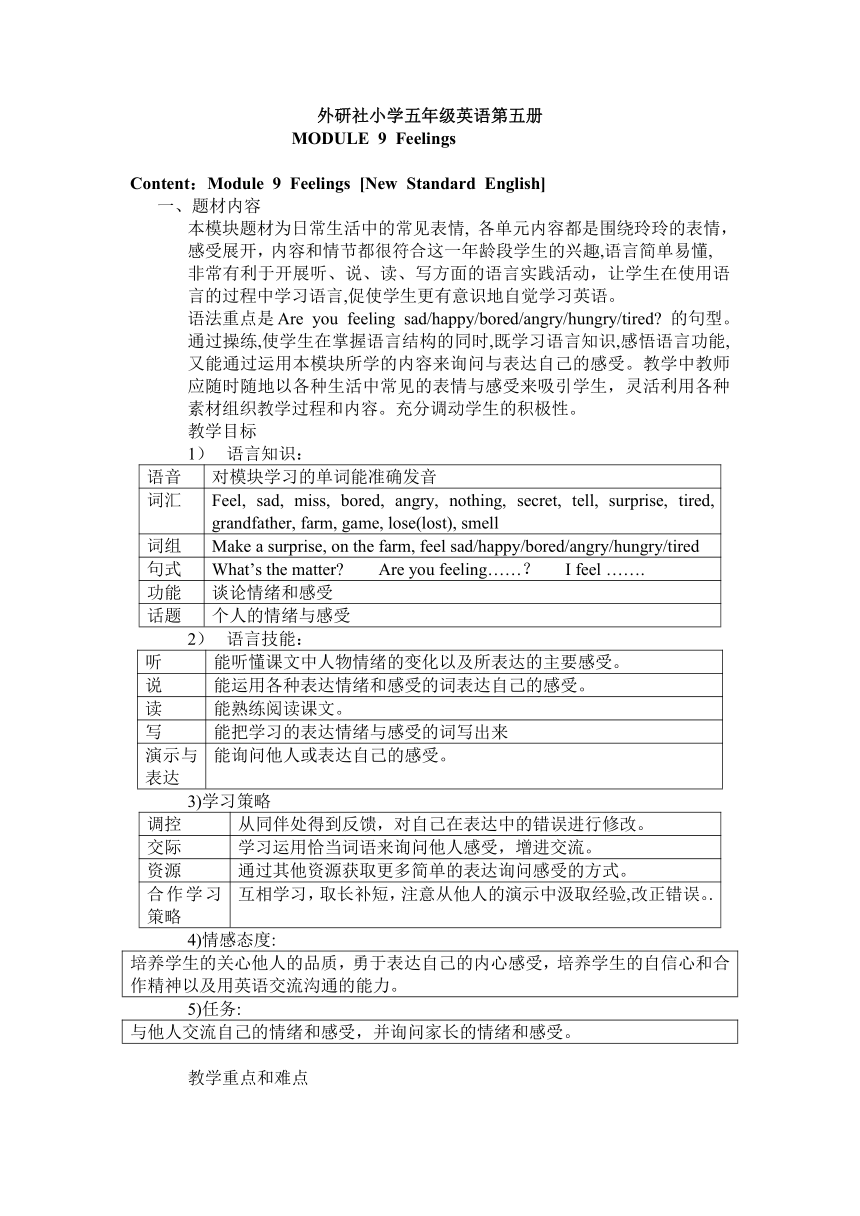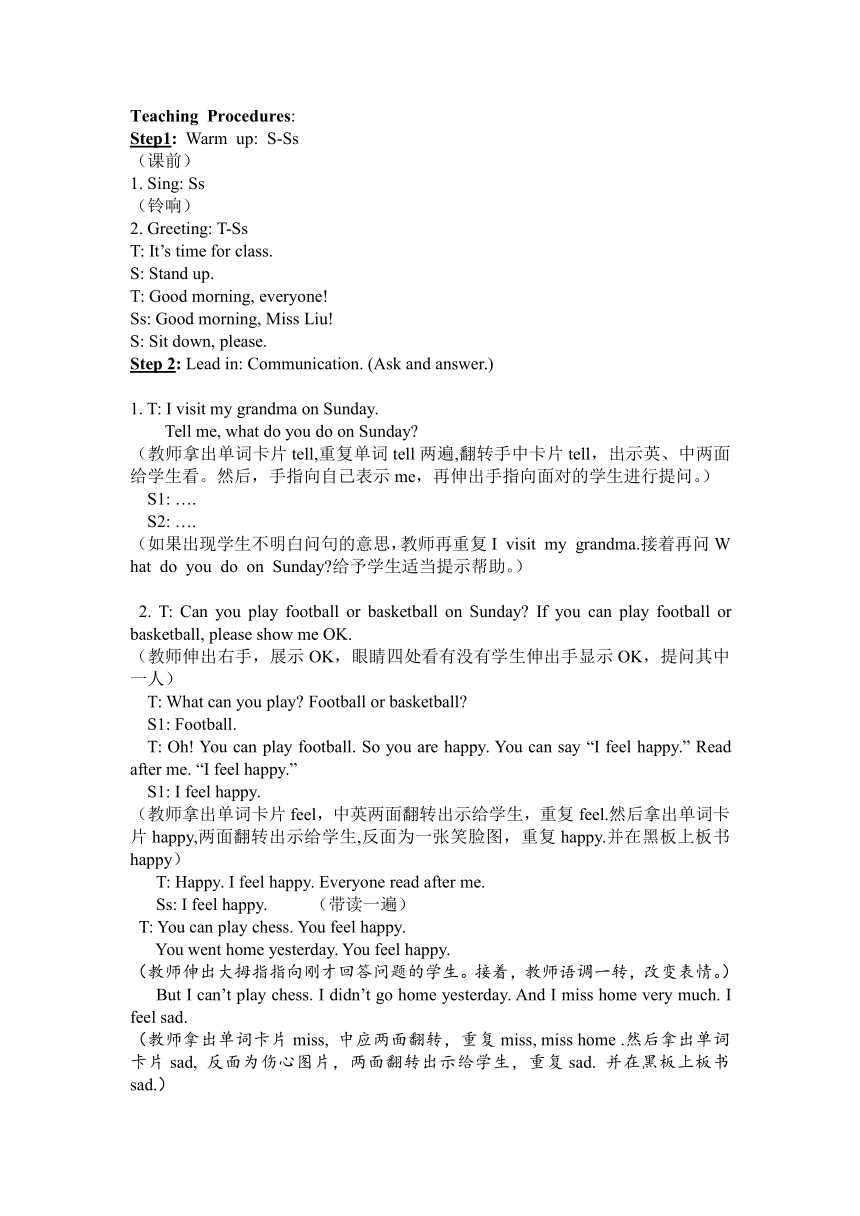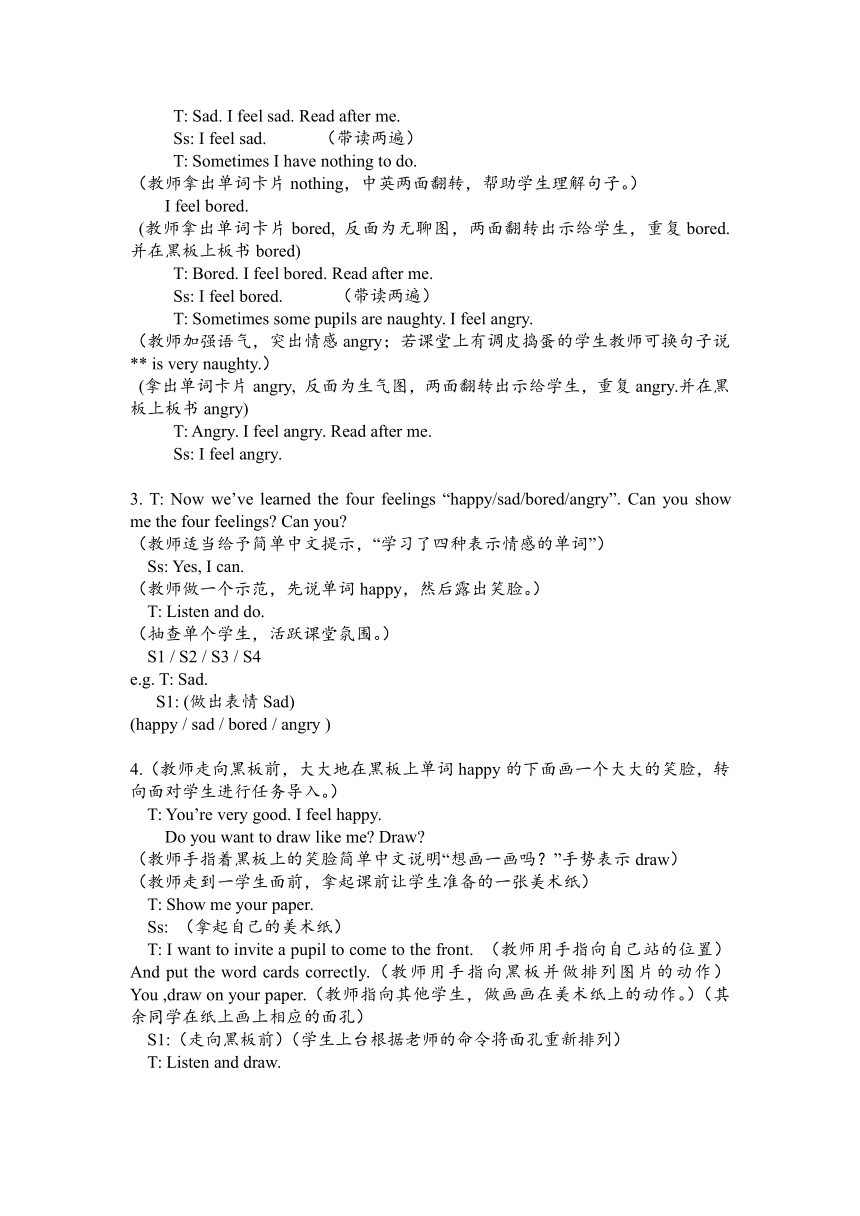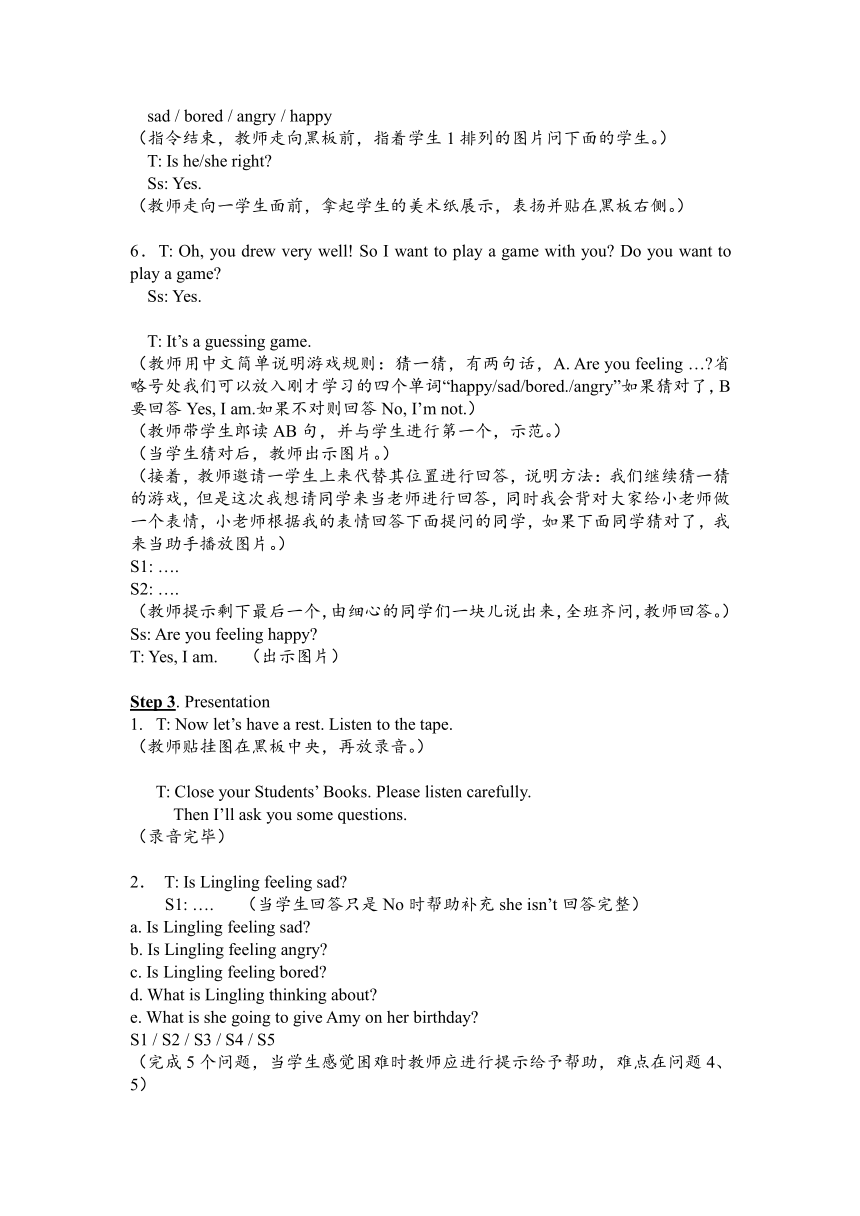外研版(三年级起点) 五年级上学期 Module 9 Feelings 教案
文档属性
| 名称 | 外研版(三年级起点) 五年级上学期 Module 9 Feelings 教案 |  | |
| 格式 | rar | ||
| 文件大小 | 21.4KB | ||
| 资源类型 | 教案 | ||
| 版本资源 | 外研版(三年级起点) | ||
| 科目 | 英语 | ||
| 更新时间 | 2009-11-17 16:12:00 | ||
图片预览





文档简介
外研社小学五年级英语第五册
MODULE 9 Feelings
Content:Module 9 Feelings [New Standard English]
一、题材内容
本模块题材为日常生活中的常见表情, 各单元内容都是围绕玲玲的表情,感受展开,内容和情节都很符合这一年龄段学生的兴趣,语言简单易懂, 非常有利于开展听、说、读、写方面的语言实践活动,让学生在使用语言的过程中学习语言,促使学生更有意识地自觉学习英语。
语法重点是Are you feeling sad/happy/bored/angry/hungry/tired 的句型。通过操练,使学生在掌握语言结构的同时,既学习语言知识,感悟语言功能,又能通过运用本模块所学的内容来询问与表达自己的感受。教学中教师应随时随地以各种生活中常见的表情与感受来吸引学生,灵活利用各种素材组织教学过程和内容。充分调动学生的积极性。
教学目标
1) 语言知识:
语音 对模块学习的单词能准确发音
词汇 Feel, sad, miss, bored, angry, nothing, secret, tell, surprise, tired, grandfather, farm, game, lose(lost), smell
词组 Make a surprise, on the farm, feel sad/happy/bored/angry/hungry/tired
句式 What’s the matter Are you feeling……? I feel …….
功能 谈论情绪和感受
话题 个人的情绪与感受
2) 语言技能:
听 能听懂课文中人物情绪的变化以及所表达的主要感受。
说 能运用各种表达情绪和感受的词表达自己的感受。
读 能熟练阅读课文。
写 能把学习的表达情绪与感受的词写出来
演示与表达 能询问他人或表达自己的感受。
3)学习策略
调控 从同伴处得到反馈,对自己在表达中的错误进行修改。
交际 学习运用恰当词语来询问他人感受,增进交流。
资源 通过其他资源获取更多简单的表达询问感受的方式。
合作学习策略 互相学习,取长补短,注意从他人的演示中汲取经验,改正错误。.
4)情感态度:
培养学生的关心他人的品质,勇于表达自己的内心感受,培养学生的自信心和合作精神以及用英语交流沟通的能力。
5)任务:
与他人交流自己的情绪和感受,并询问家长的情绪和感受。
教学重点和难点
1.掌握本课词汇:Feel, sad, miss, bored, angry, nothing, secret, tell, surprise, tired, grandfather, farm, game, lose(lost), smell
2.本课重点句型:What’s the matter Are you feeling … I feel …
教学方法
基于课程改革的理念及“第二语言习得论”,培养实现人的可持续发展和人的主体精神的自我完善和发展所必需的能力和素质,运用任务型教学途径,围绕核心任务,设定小任务,开展和谐愉悦的课堂活动,强调兴趣第一的原则,初步设计“P—T—P”自主学习立体模式:pre-task…task-cycle…post-task。
二、教材处理
核心任务:能够运用所学句型结构询问他人,并表达自己的感受。三个环节如下:
pre-task:学生联系生活实际,激活背景知识,。
task –cycle:通过整个模块的听说读写的训练,强化对感情与情绪表达能力,为完成任务做好铺垫
post-task:达成任务,展示成果,反馈学习情况
三、教材安排
根据学生学习英语的特点和规律,我们把本模块划分为2课时:
Period 1: Vocabulary and Listening &Pronunciation and Speaking
Period 2: Communicating & Module Task & Language in use
注:教学时应根据学生的学、生活实际水平、接受程度及课堂出现的临时状况进行运用、调整及筛选。
『教学设计』
Title: Module 9 Feelings
Unit 1 Are you feeling sad
Period 1: Listening and Vocabulary &Pronunciation and Speaking
Teaching Content: Are you feeling sad
Teaching Aims and Demands:
1. Language Knowledge
Key vocabulary and phrases: feel, sad, miss, bored, angry, nothing, tell, surprise, tired
Key structure: Are you feeling sad (重点)
2. Listening skill: To get the information about the speaker’s feeling through catching main words from other’s expression. (难点)
3. Speaking skill: To express one’s own feelings.
4. Attitudes: Develop the ability of express one’s own feeling..
Learning strategies:
Bottom –up approach and listening to the tape and do some exercises.
Teaching Aids:
Teaching tools: Tape recorder, video, word cards, chalk, blackboard
Students’ tools: SB, pen/pencil, a paper
Teaching Procedures:
Step1: Warm up: S-Ss
(课前)
1. Sing: Ss
(铃响)
2. Greeting: T-Ss
T: It’s time for class.
S: Stand up.
T: Good morning, everyone!
Ss: Good morning, Miss Liu!
S: Sit down, please.
Step 2: Lead in: Communication. (Ask and answer.)
1. T: I visit my grandma on Sunday.
Tell me, what do you do on Sunday
(教师拿出单词卡片tell,重复单词tell两遍,翻转手中卡片tell,出示英、中两面给学生看。然后,手指向自己表示me,再伸出手指向面对的学生进行提问。)
S1: ….
S2: ….
(如果出现学生不明白问句的意思,教师再重复I visit my grandma.接着再问What do you do on Sunday 给予学生适当提示帮助。)
2. T: Can you play football or basketball on Sunday If you can play football or basketball, please show me OK.
(教师伸出右手,展示OK,眼睛四处看有没有学生伸出手显示OK,提问其中一人)
T: What can you play Football or basketball
S1: Football.
T: Oh! You can play football. So you are happy. You can say “I feel happy.” Read after me. “I feel happy.”
S1: I feel happy.
(教师拿出单词卡片feel,中英两面翻转出示给学生,重复feel.然后拿出单词卡片happy,两面翻转出示给学生,反面为一张笑脸图,重复happy.并在黑板上板书happy)
T: Happy. I feel happy. Everyone read after me.
Ss: I feel happy. (带读一遍)
T: You can play chess. You feel happy.
You went home yesterday. You feel happy.
(教师伸出大拇指指向刚才回答问题的学生。接着,教师语调一转,改变表情。)
But I can’t play chess. I didn’t go home yesterday. And I miss home very much. I feel sad.
(教师拿出单词卡片miss, 中应两面翻转,重复miss, miss home .然后拿出单词卡片sad, 反面为伤心图片,两面翻转出示给学生,重复sad. 并在黑板上板书sad.)
T: Sad. I feel sad. Read after me.
Ss: I feel sad. (带读两遍)
T: Sometimes I have nothing to do.
(教师拿出单词卡片nothing,中英两面翻转,帮助学生理解句子。)
I feel bored.
(教师拿出单词卡片bored, 反面为无聊图,两面翻转出示给学生,重复bored.并在黑板上板书bored)
T: Bored. I feel bored. Read after me.
Ss: I feel bored. (带读两遍)
T: Sometimes some pupils are naughty. I feel angry.
(教师加强语气,突出情感angry;若课堂上有调皮捣蛋的学生教师可换句子说** is very naughty.)
(拿出单词卡片angry, 反面为生气图,两面翻转出示给学生,重复angry.并在黑板上板书angry)
T: Angry. I feel angry. Read after me.
Ss: I feel angry.
3. T: Now we’ve learned the four feelings “happy/sad/bored/angry”. Can you show me the four feelings Can you
(教师适当给予简单中文提示,“学习了四种表示情感的单词”)
Ss: Yes, I can.
(教师做一个示范,先说单词happy,然后露出笑脸。)
T: Listen and do.
(抽查单个学生,活跃课堂氛围。)
S1 / S2 / S3 / S4
e.g. T: Sad.
S1: (做出表情Sad)
(happy / sad / bored / angry )
4.(教师走向黑板前,大大地在黑板上单词happy的下面画一个大大的笑脸,转向面对学生进行任务导入。)
T: You’re very good. I feel happy.
Do you want to draw like me Draw
(教师手指着黑板上的笑脸简单中文说明“想画一画吗?”手势表示draw)
(教师走到一学生面前,拿起课前让学生准备的一张美术纸)
T: Show me your paper.
Ss: (拿起自己的美术纸)
T: I want to invite a pupil to come to the front. (教师用手指向自己站的位置)And put the word cards correctly.(教师用手指向黑板并做排列图片的动作)You ,draw on your paper.(教师指向其他学生,做画画在美术纸上的动作。)(其余同学在纸上画上相应的面孔)
S1:(走向黑板前)(学生上台根据老师的命令将面孔重新排列)
T: Listen and draw.
sad / bored / angry / happy
(指令结束,教师走向黑板前,指着学生1排列的图片问下面的学生。)
T: Is he/she right
Ss: Yes.
(教师走向一学生面前,拿起学生的美术纸展示,表扬并贴在黑板右侧。)
6.T: Oh, you drew very well! So I want to play a game with you Do you want to play a game
Ss: Yes.
T: It’s a guessing game.
(教师用中文简单说明游戏规则:猜一猜,有两句话,A. Are you feeling … 省略号处我们可以放入刚才学习的四个单词“happy/sad/bored./angry”如果猜对了,B要回答Yes, I am.如果不对则回答No, I’m not.)
(教师带学生郎读AB句,并与学生进行第一个,示范。)
(当学生猜对后,教师出示图片。)
(接着,教师邀请一学生上来代替其位置进行回答,说明方法:我们继续猜一猜的游戏,但是这次我想请同学来当老师进行回答,同时我会背对大家给小老师做一个表情,小老师根据我的表情回答下面提问的同学,如果下面同学猜对了,我来当助手播放图片。)
S1: ….
S2: ….
(教师提示剩下最后一个,由细心的同学们一块儿说出来,全班齐问,教师回答。)
Ss: Are you feeling happy
T: Yes, I am. (出示图片)
Step 3. Presentation
1. T: Now let’s have a rest. Listen to the tape.
(教师贴挂图在黑板中央,再放录音。)
T: Close your Students’ Books. Please listen carefully.
Then I’ll ask you some questions.
(录音完毕)
2. T: Is Lingling feeling sad
S1: …. (当学生回答只是No时帮助补充she isn’t回答完整)
a. Is Lingling feeling sad
b. Is Lingling feeling angry
c. Is Lingling feeling bored
d. What is Lingling thinking about
e. What is she going to give Amy on her birthday
S1 / S2 / S3 / S4 / S5
(完成5个问题,当学生感觉困难时教师应进行提示给予帮助,难点在问题4、5)
3. Listen and underline the new words.*
T: Open your books and take out your pens. Listen and underline.
(教师放录音,做划线动作)
(录音完毕)
T: Can you read it Who can No.1
(教师做举手动作,让学生自己来读,若学生正确,全班跟读;若发音有问题,如其他学生提出意见,有其他学生进行纠正,如没有学生朗读正确,则需板书说明带读该单词。)
(教师板书单词nothing,写出th的音标,讲解发音方法,手势辅助。)
(学生拼读、书写和认读单词,教师应及时纠正学生字母或单词发音错误的地方。)
e.g. (示范)T: n/o/t/h/i/n/g (书空) nothing
4. Listen and repeat.*
(教师播放录音,每句按暂停学生跟读;教师带读难句:I’m going to make a surprise cake on your birthday.)
5. Act it out.*
Group 1/2: Amy
Group 3/4: Lingling
Step 4: Drills
1. T: Good! But Lingling and Amy want to say now. What are they talking about
a. Listen and repeat.
(教师播放录音,每句暂停。)
(录音结束)
b. Work in pairs.
(教师告诉学生两人同桌一组,一问一答,时间一分钟。)
c. Show time.
(教师让两组学生展示)
2.(总结)句型积累
T: Today we learn about four feelings. We have different feelings. We feel happy, sad, bored and angry. But how to express surprise Look
(教师展示惊奇的图片。)
(拿出单词卡片,反面为图,翻转给学生看,surprise , 读两遍。他)
Step 5.Homework
1. 与他人交流自己的情绪和感受,并询问家长的情绪和感受.同时,请在作业本上记录下一条信息,如:
Sam: Are you feeling happy, Dad
Dad: Yes, I am.
2. 连词成句: the, what’s , matter ( )
3. 收集表示惊奇的句子或短语。
Step 6. Class over
T: OK. I have to say “Time is up.”
M: Stand up.
T: Goodbye, students.
Ss: Goodbye, Miss Liu!
Period 2: I feel happy.
Teaching Content: Communicating & Module Task & Language in use
Teaching Aims and Demands:
1. Language Knowledge
Key vocabulary and phrases: grandfather, farm, on the farm, game, lose(lost), smell
Key structure: You’re happy/sad/angry/bored/tried.
How do they feel
I feel…
Do you feel tried (重点)
Phonetic alphabet: ts; ds; tr; dr; ch; j, dg
Poem
2. Listening skill: To get the information about the speaker’s feeling through catching main words from other’s expression and the reasons of getting such feeling. (难点)
3. Speaking skill: To express or write one’s own feelings
4. Attitudes: Develop the ability of express one’s own feeling and ask others’ feelings.
Learning strategies:
Bottom –up approach and listening to the tape and do some exercises.
Teaching Aids:
Teaching tools: Tape recorder, video, word cards, chalk, blackboard, soap, pictures
Teaching Procedures:
Step1: Warm up:
S-Ss
(课前)
1. Sing: Ss
(铃响)
2. Greeting: T-Ss
T: It’s time for class.
S: Stand up.
T: Good morning, everyone!
Ss: Good morning, Miss Liu!
S: Sit down, please.
Step 2: Lead in: Communication. (Ask and answer.)
1. Warm-up:
T: (cards in hand)First let’s have a game. (take out the picture of game, read two times ‘game’ 游戏) We have learnt the pattern “Are you feeling sad/happy/angry/tired ” in last class, now I am going to choose two students to perform it, and put the right picture on the blackboard. OK, who wants to have a try
Ss put up their hands.
T: Choose two students.
(The students come to the front and perform.)
T: Well done. Please go back and sit down.
T: Did you have some happy or sad, tired, bored, angry experience (若学生听不懂则用中文询问。) Can you share with us
Ss: put up their hands.
(Call some students and encourage them to express in English.)
T: OK. In this class, we are going to learn how to express the reasons of getting different feelings in English. (并用中文重复一遍“这节课我们要学习用英语表达产生各种心情的原因。”)
Step 3. Presentation
⑴.Learn new words
1. T writes ‘go out’ on the blackboard and do gesture asking ‘Do you want to go out to play ’
(若学生不能理解,教师可以请一名较好的学生配合。)
‘go out’ read after me. (Twice)
2. The teacher takes out a soap, and do the action to smell it, then writes the word on the blackboard. Repeat the action.
‘smell’ read after me.(two times)
Now, guess what’s the meaning of this word
Ss: 肥皂。
T:Good.
3. The teacher takes out a picture of farm and asks the students” what’s this ”
Ss:农场。
T: Right. It’s a farm. ‘farm’, read after me.(twice)
那么,在农场上怎么说呢?Look at the blackboard. ‘on the farm’.
4.T: I got a pen from ‘Lost and Found Office’.
(write ‘lost’ on the blackboard.)
(汉语解释lost是丢失的意思,他是一个过去时,他的动词原形为lose 并板书)
4. T: How to speak ‘爸爸’ in English
Ss: Father.
T: Then how to speak ‘爷爷’ in English
It’s ‘grandfather’. ‘Grandfather’ read after me.
⑵. Learn the text.
1. T: Now open your books and turn to page 36. First, look at the pictures and get what they are doing, and now I’m going to play the tape and you should listen carefully and get the information of how do they feel.
(The teacher plays the tape.)
Now let’s listen the tape again, you should listen carefully and write down the right word.
OK, who can tell me the answers Before you answer my question, please read the whole sentence.
Ss: put up their hands. (The teacher selects a student)
…… read and answer.
(共找五个学生,每个学生回答一部分。若学生回答错了,则找另外一位。)
T: Now work in pairs. One student asks “How do you feel ” The other answers “I feel……” Then swap the roles.
Stop please.
Now let play a game. We need three students; one student asks “How do you feel ” Another student does the mime and the third student answers the first student according the second student’s mime.
(若学生们听不懂,可再用汉语给学生们讲一遍。表演出色的一组可给与适当的奖励。)
⑶ Learn the Phonetic Alphabet
T: All of you did very well. And now, look at activity 3; let’s learn some new phonetic alphabets. Give you three minutes to read these words, and discuss in groups trying to find their similarities.
Ss work in groups and discuss.
T: Who can read these words to me Put up your hands.
Ss: cats, coats; beds; friends; trains; trousers; driver; dress; chair; lunch; jacket; bridge.
T: Well done. Now, who can tell me the similarities of each group Have a try. You can speak in Chinese.
S1: 前四组中的单词每组都有两个相同的字母,而且他们都在同一位置。
S2: 第一组单词中的带色的字母都发/ts/音,第二组发/dz/ 音, 第三组发/tr/音,第四组发/dr/音,第五组发/t /,第六组发/d /音。
T: Good.
(若学生答不上来则多找一些学生来回答,并给与提示。)
Now let’s read the words and their phonetic alphabet together.
(Read one time.)
Now, let’s divide our class into two groups, group one and group two, group one read the word I point, and group two read the word that has the phoneme with the first word.
(教师可在用中文解释,将全班分成两组,教师指一个单词,第一组学生读,第二组要读出和它有相同音素的单词。)
⑷ Learn the poem
T: I guess you must feel tired, let’s have a relaxation by learning a poem.
(教师可再用汉语讲一遍,以帮助学生理解。)
First listen to the tape.
(Play the tape.)
Then read after the tape.
Step 4 Homework
1. To express your feelings to others and tell them the reason of having such feelings.
2. Read the poem.
Step 5. Class over
T: OK. I have to say “Time is up.”
M: Stand up.
T: Goodbye, students.
Ss: Goodbye, Miss Liu!
MODULE 9 Feelings
Content:Module 9 Feelings [New Standard English]
一、题材内容
本模块题材为日常生活中的常见表情, 各单元内容都是围绕玲玲的表情,感受展开,内容和情节都很符合这一年龄段学生的兴趣,语言简单易懂, 非常有利于开展听、说、读、写方面的语言实践活动,让学生在使用语言的过程中学习语言,促使学生更有意识地自觉学习英语。
语法重点是Are you feeling sad/happy/bored/angry/hungry/tired 的句型。通过操练,使学生在掌握语言结构的同时,既学习语言知识,感悟语言功能,又能通过运用本模块所学的内容来询问与表达自己的感受。教学中教师应随时随地以各种生活中常见的表情与感受来吸引学生,灵活利用各种素材组织教学过程和内容。充分调动学生的积极性。
教学目标
1) 语言知识:
语音 对模块学习的单词能准确发音
词汇 Feel, sad, miss, bored, angry, nothing, secret, tell, surprise, tired, grandfather, farm, game, lose(lost), smell
词组 Make a surprise, on the farm, feel sad/happy/bored/angry/hungry/tired
句式 What’s the matter Are you feeling……? I feel …….
功能 谈论情绪和感受
话题 个人的情绪与感受
2) 语言技能:
听 能听懂课文中人物情绪的变化以及所表达的主要感受。
说 能运用各种表达情绪和感受的词表达自己的感受。
读 能熟练阅读课文。
写 能把学习的表达情绪与感受的词写出来
演示与表达 能询问他人或表达自己的感受。
3)学习策略
调控 从同伴处得到反馈,对自己在表达中的错误进行修改。
交际 学习运用恰当词语来询问他人感受,增进交流。
资源 通过其他资源获取更多简单的表达询问感受的方式。
合作学习策略 互相学习,取长补短,注意从他人的演示中汲取经验,改正错误。.
4)情感态度:
培养学生的关心他人的品质,勇于表达自己的内心感受,培养学生的自信心和合作精神以及用英语交流沟通的能力。
5)任务:
与他人交流自己的情绪和感受,并询问家长的情绪和感受。
教学重点和难点
1.掌握本课词汇:Feel, sad, miss, bored, angry, nothing, secret, tell, surprise, tired, grandfather, farm, game, lose(lost), smell
2.本课重点句型:What’s the matter Are you feeling … I feel …
教学方法
基于课程改革的理念及“第二语言习得论”,培养实现人的可持续发展和人的主体精神的自我完善和发展所必需的能力和素质,运用任务型教学途径,围绕核心任务,设定小任务,开展和谐愉悦的课堂活动,强调兴趣第一的原则,初步设计“P—T—P”自主学习立体模式:pre-task…task-cycle…post-task。
二、教材处理
核心任务:能够运用所学句型结构询问他人,并表达自己的感受。三个环节如下:
pre-task:学生联系生活实际,激活背景知识,。
task –cycle:通过整个模块的听说读写的训练,强化对感情与情绪表达能力,为完成任务做好铺垫
post-task:达成任务,展示成果,反馈学习情况
三、教材安排
根据学生学习英语的特点和规律,我们把本模块划分为2课时:
Period 1: Vocabulary and Listening &Pronunciation and Speaking
Period 2: Communicating & Module Task & Language in use
注:教学时应根据学生的学、生活实际水平、接受程度及课堂出现的临时状况进行运用、调整及筛选。
『教学设计』
Title: Module 9 Feelings
Unit 1 Are you feeling sad
Period 1: Listening and Vocabulary &Pronunciation and Speaking
Teaching Content: Are you feeling sad
Teaching Aims and Demands:
1. Language Knowledge
Key vocabulary and phrases: feel, sad, miss, bored, angry, nothing, tell, surprise, tired
Key structure: Are you feeling sad (重点)
2. Listening skill: To get the information about the speaker’s feeling through catching main words from other’s expression. (难点)
3. Speaking skill: To express one’s own feelings.
4. Attitudes: Develop the ability of express one’s own feeling..
Learning strategies:
Bottom –up approach and listening to the tape and do some exercises.
Teaching Aids:
Teaching tools: Tape recorder, video, word cards, chalk, blackboard
Students’ tools: SB, pen/pencil, a paper
Teaching Procedures:
Step1: Warm up: S-Ss
(课前)
1. Sing: Ss
(铃响)
2. Greeting: T-Ss
T: It’s time for class.
S: Stand up.
T: Good morning, everyone!
Ss: Good morning, Miss Liu!
S: Sit down, please.
Step 2: Lead in: Communication. (Ask and answer.)
1. T: I visit my grandma on Sunday.
Tell me, what do you do on Sunday
(教师拿出单词卡片tell,重复单词tell两遍,翻转手中卡片tell,出示英、中两面给学生看。然后,手指向自己表示me,再伸出手指向面对的学生进行提问。)
S1: ….
S2: ….
(如果出现学生不明白问句的意思,教师再重复I visit my grandma.接着再问What do you do on Sunday 给予学生适当提示帮助。)
2. T: Can you play football or basketball on Sunday If you can play football or basketball, please show me OK.
(教师伸出右手,展示OK,眼睛四处看有没有学生伸出手显示OK,提问其中一人)
T: What can you play Football or basketball
S1: Football.
T: Oh! You can play football. So you are happy. You can say “I feel happy.” Read after me. “I feel happy.”
S1: I feel happy.
(教师拿出单词卡片feel,中英两面翻转出示给学生,重复feel.然后拿出单词卡片happy,两面翻转出示给学生,反面为一张笑脸图,重复happy.并在黑板上板书happy)
T: Happy. I feel happy. Everyone read after me.
Ss: I feel happy. (带读一遍)
T: You can play chess. You feel happy.
You went home yesterday. You feel happy.
(教师伸出大拇指指向刚才回答问题的学生。接着,教师语调一转,改变表情。)
But I can’t play chess. I didn’t go home yesterday. And I miss home very much. I feel sad.
(教师拿出单词卡片miss, 中应两面翻转,重复miss, miss home .然后拿出单词卡片sad, 反面为伤心图片,两面翻转出示给学生,重复sad. 并在黑板上板书sad.)
T: Sad. I feel sad. Read after me.
Ss: I feel sad. (带读两遍)
T: Sometimes I have nothing to do.
(教师拿出单词卡片nothing,中英两面翻转,帮助学生理解句子。)
I feel bored.
(教师拿出单词卡片bored, 反面为无聊图,两面翻转出示给学生,重复bored.并在黑板上板书bored)
T: Bored. I feel bored. Read after me.
Ss: I feel bored. (带读两遍)
T: Sometimes some pupils are naughty. I feel angry.
(教师加强语气,突出情感angry;若课堂上有调皮捣蛋的学生教师可换句子说** is very naughty.)
(拿出单词卡片angry, 反面为生气图,两面翻转出示给学生,重复angry.并在黑板上板书angry)
T: Angry. I feel angry. Read after me.
Ss: I feel angry.
3. T: Now we’ve learned the four feelings “happy/sad/bored/angry”. Can you show me the four feelings Can you
(教师适当给予简单中文提示,“学习了四种表示情感的单词”)
Ss: Yes, I can.
(教师做一个示范,先说单词happy,然后露出笑脸。)
T: Listen and do.
(抽查单个学生,活跃课堂氛围。)
S1 / S2 / S3 / S4
e.g. T: Sad.
S1: (做出表情Sad)
(happy / sad / bored / angry )
4.(教师走向黑板前,大大地在黑板上单词happy的下面画一个大大的笑脸,转向面对学生进行任务导入。)
T: You’re very good. I feel happy.
Do you want to draw like me Draw
(教师手指着黑板上的笑脸简单中文说明“想画一画吗?”手势表示draw)
(教师走到一学生面前,拿起课前让学生准备的一张美术纸)
T: Show me your paper.
Ss: (拿起自己的美术纸)
T: I want to invite a pupil to come to the front. (教师用手指向自己站的位置)And put the word cards correctly.(教师用手指向黑板并做排列图片的动作)You ,draw on your paper.(教师指向其他学生,做画画在美术纸上的动作。)(其余同学在纸上画上相应的面孔)
S1:(走向黑板前)(学生上台根据老师的命令将面孔重新排列)
T: Listen and draw.
sad / bored / angry / happy
(指令结束,教师走向黑板前,指着学生1排列的图片问下面的学生。)
T: Is he/she right
Ss: Yes.
(教师走向一学生面前,拿起学生的美术纸展示,表扬并贴在黑板右侧。)
6.T: Oh, you drew very well! So I want to play a game with you Do you want to play a game
Ss: Yes.
T: It’s a guessing game.
(教师用中文简单说明游戏规则:猜一猜,有两句话,A. Are you feeling … 省略号处我们可以放入刚才学习的四个单词“happy/sad/bored./angry”如果猜对了,B要回答Yes, I am.如果不对则回答No, I’m not.)
(教师带学生郎读AB句,并与学生进行第一个,示范。)
(当学生猜对后,教师出示图片。)
(接着,教师邀请一学生上来代替其位置进行回答,说明方法:我们继续猜一猜的游戏,但是这次我想请同学来当老师进行回答,同时我会背对大家给小老师做一个表情,小老师根据我的表情回答下面提问的同学,如果下面同学猜对了,我来当助手播放图片。)
S1: ….
S2: ….
(教师提示剩下最后一个,由细心的同学们一块儿说出来,全班齐问,教师回答。)
Ss: Are you feeling happy
T: Yes, I am. (出示图片)
Step 3. Presentation
1. T: Now let’s have a rest. Listen to the tape.
(教师贴挂图在黑板中央,再放录音。)
T: Close your Students’ Books. Please listen carefully.
Then I’ll ask you some questions.
(录音完毕)
2. T: Is Lingling feeling sad
S1: …. (当学生回答只是No时帮助补充she isn’t回答完整)
a. Is Lingling feeling sad
b. Is Lingling feeling angry
c. Is Lingling feeling bored
d. What is Lingling thinking about
e. What is she going to give Amy on her birthday
S1 / S2 / S3 / S4 / S5
(完成5个问题,当学生感觉困难时教师应进行提示给予帮助,难点在问题4、5)
3. Listen and underline the new words.*
T: Open your books and take out your pens. Listen and underline.
(教师放录音,做划线动作)
(录音完毕)
T: Can you read it Who can No.1
(教师做举手动作,让学生自己来读,若学生正确,全班跟读;若发音有问题,如其他学生提出意见,有其他学生进行纠正,如没有学生朗读正确,则需板书说明带读该单词。)
(教师板书单词nothing,写出th的音标,讲解发音方法,手势辅助。)
(学生拼读、书写和认读单词,教师应及时纠正学生字母或单词发音错误的地方。)
e.g. (示范)T: n/o/t/h/i/n/g (书空) nothing
4. Listen and repeat.*
(教师播放录音,每句按暂停学生跟读;教师带读难句:I’m going to make a surprise cake on your birthday.)
5. Act it out.*
Group 1/2: Amy
Group 3/4: Lingling
Step 4: Drills
1. T: Good! But Lingling and Amy want to say now. What are they talking about
a. Listen and repeat.
(教师播放录音,每句暂停。)
(录音结束)
b. Work in pairs.
(教师告诉学生两人同桌一组,一问一答,时间一分钟。)
c. Show time.
(教师让两组学生展示)
2.(总结)句型积累
T: Today we learn about four feelings. We have different feelings. We feel happy, sad, bored and angry. But how to express surprise Look
(教师展示惊奇的图片。)
(拿出单词卡片,反面为图,翻转给学生看,surprise , 读两遍。他)
Step 5.Homework
1. 与他人交流自己的情绪和感受,并询问家长的情绪和感受.同时,请在作业本上记录下一条信息,如:
Sam: Are you feeling happy, Dad
Dad: Yes, I am.
2. 连词成句: the, what’s , matter ( )
3. 收集表示惊奇的句子或短语。
Step 6. Class over
T: OK. I have to say “Time is up.”
M: Stand up.
T: Goodbye, students.
Ss: Goodbye, Miss Liu!
Period 2: I feel happy.
Teaching Content: Communicating & Module Task & Language in use
Teaching Aims and Demands:
1. Language Knowledge
Key vocabulary and phrases: grandfather, farm, on the farm, game, lose(lost), smell
Key structure: You’re happy/sad/angry/bored/tried.
How do they feel
I feel…
Do you feel tried (重点)
Phonetic alphabet: ts; ds; tr; dr; ch; j, dg
Poem
2. Listening skill: To get the information about the speaker’s feeling through catching main words from other’s expression and the reasons of getting such feeling. (难点)
3. Speaking skill: To express or write one’s own feelings
4. Attitudes: Develop the ability of express one’s own feeling and ask others’ feelings.
Learning strategies:
Bottom –up approach and listening to the tape and do some exercises.
Teaching Aids:
Teaching tools: Tape recorder, video, word cards, chalk, blackboard, soap, pictures
Teaching Procedures:
Step1: Warm up:
S-Ss
(课前)
1. Sing: Ss
(铃响)
2. Greeting: T-Ss
T: It’s time for class.
S: Stand up.
T: Good morning, everyone!
Ss: Good morning, Miss Liu!
S: Sit down, please.
Step 2: Lead in: Communication. (Ask and answer.)
1. Warm-up:
T: (cards in hand)First let’s have a game. (take out the picture of game, read two times ‘game’ 游戏) We have learnt the pattern “Are you feeling sad/happy/angry/tired ” in last class, now I am going to choose two students to perform it, and put the right picture on the blackboard. OK, who wants to have a try
Ss put up their hands.
T: Choose two students.
(The students come to the front and perform.)
T: Well done. Please go back and sit down.
T: Did you have some happy or sad, tired, bored, angry experience (若学生听不懂则用中文询问。) Can you share with us
Ss: put up their hands.
(Call some students and encourage them to express in English.)
T: OK. In this class, we are going to learn how to express the reasons of getting different feelings in English. (并用中文重复一遍“这节课我们要学习用英语表达产生各种心情的原因。”)
Step 3. Presentation
⑴.Learn new words
1. T writes ‘go out’ on the blackboard and do gesture asking ‘Do you want to go out to play ’
(若学生不能理解,教师可以请一名较好的学生配合。)
‘go out’ read after me. (Twice)
2. The teacher takes out a soap, and do the action to smell it, then writes the word on the blackboard. Repeat the action.
‘smell’ read after me.(two times)
Now, guess what’s the meaning of this word
Ss: 肥皂。
T:Good.
3. The teacher takes out a picture of farm and asks the students” what’s this ”
Ss:农场。
T: Right. It’s a farm. ‘farm’, read after me.(twice)
那么,在农场上怎么说呢?Look at the blackboard. ‘on the farm’.
4.T: I got a pen from ‘Lost and Found Office’.
(write ‘lost’ on the blackboard.)
(汉语解释lost是丢失的意思,他是一个过去时,他的动词原形为lose 并板书)
4. T: How to speak ‘爸爸’ in English
Ss: Father.
T: Then how to speak ‘爷爷’ in English
It’s ‘grandfather’. ‘Grandfather’ read after me.
⑵. Learn the text.
1. T: Now open your books and turn to page 36. First, look at the pictures and get what they are doing, and now I’m going to play the tape and you should listen carefully and get the information of how do they feel.
(The teacher plays the tape.)
Now let’s listen the tape again, you should listen carefully and write down the right word.
OK, who can tell me the answers Before you answer my question, please read the whole sentence.
Ss: put up their hands. (The teacher selects a student)
…… read and answer.
(共找五个学生,每个学生回答一部分。若学生回答错了,则找另外一位。)
T: Now work in pairs. One student asks “How do you feel ” The other answers “I feel……” Then swap the roles.
Stop please.
Now let play a game. We need three students; one student asks “How do you feel ” Another student does the mime and the third student answers the first student according the second student’s mime.
(若学生们听不懂,可再用汉语给学生们讲一遍。表演出色的一组可给与适当的奖励。)
⑶ Learn the Phonetic Alphabet
T: All of you did very well. And now, look at activity 3; let’s learn some new phonetic alphabets. Give you three minutes to read these words, and discuss in groups trying to find their similarities.
Ss work in groups and discuss.
T: Who can read these words to me Put up your hands.
Ss: cats, coats; beds; friends; trains; trousers; driver; dress; chair; lunch; jacket; bridge.
T: Well done. Now, who can tell me the similarities of each group Have a try. You can speak in Chinese.
S1: 前四组中的单词每组都有两个相同的字母,而且他们都在同一位置。
S2: 第一组单词中的带色的字母都发/ts/音,第二组发/dz/ 音, 第三组发/tr/音,第四组发/dr/音,第五组发/t /,第六组发/d /音。
T: Good.
(若学生答不上来则多找一些学生来回答,并给与提示。)
Now let’s read the words and their phonetic alphabet together.
(Read one time.)
Now, let’s divide our class into two groups, group one and group two, group one read the word I point, and group two read the word that has the phoneme with the first word.
(教师可在用中文解释,将全班分成两组,教师指一个单词,第一组学生读,第二组要读出和它有相同音素的单词。)
⑷ Learn the poem
T: I guess you must feel tired, let’s have a relaxation by learning a poem.
(教师可再用汉语讲一遍,以帮助学生理解。)
First listen to the tape.
(Play the tape.)
Then read after the tape.
Step 4 Homework
1. To express your feelings to others and tell them the reason of having such feelings.
2. Read the poem.
Step 5. Class over
T: OK. I have to say “Time is up.”
M: Stand up.
T: Goodbye, students.
Ss: Goodbye, Miss Liu!
同课章节目录
- Module 1
- Unit 1 Did you come back yesterday?
- Unit 2 We bought ice creams.
- Module 2
- Unit 1 What did you buy?
- Unit 2 How much cheese did you buy?
- Module 3
- Unit 1 Where did you go?
- Unit 2 Daming took a photo of his father.
- Module 4
- Unit 1 Mum bought a new T-shirt for me.
- Unit 2 What's the matter with Daming?
- Module 5
- Unit 1 There are only nineteen crayons
- Unit 2 There are forty.
- Module 6
- Unit 1 You can play football well.
- Unit 2 He ran very fast.
- Module 7
- Unit 1 He can't see.
- Unit 2 This little girl can't walk.
- Module 8
- Unit 1 What time does your school start?
- Unit 2 Yesterday I went to Sam and Amy's school.
- Module 9
- Unit 1 Are you feeling bored?
- Unit 2 I feel happy.
- Review Module
- Unit 1
- Unit 2
- Module 10
- Unit 1 He was in the kitchen.
- Unit 2 Don't shout, please!
- 旧版资料
- Module 1 London
- Module 2 Shopping
- Module 3 At the Weekend
- Module 4 Possession
- Module 5 In Class
- Module 6 Self-assessment
- Module 7 Community
- Module 8 School
- Module 9 Feelings
- Module 10 Manners
- Review Module
